Response
We were most intrigued by the recent correspondence by Randis et al, suggesting that tumor necrosis factor α (TNFα)–induced E-selectin–dependent slow rolling occurred in endothelium via class I phosphoinositide 3-kinases (PI3K) when fluorescent imaging and microscissors were used for tissue dissection. By contrast, no role for PI3K could be seen in endothelial E-selectin function when white-light imaging and electrocautery were used as described by Liu et al.1 The authors directly compared the 2 techniques and concluded that the results may be related to the type of imaging and surgical approaches one uses and suggested that appropriate surgery needs to be considered when studying intracellular signaling pathways. However, what is the appropriate surgical technique for experiments? Surgical intervention however minor does induce some inflammation as was shown more than a century ago by Cohnheim when he exteriorized and imaged otherwise unperturbed frog tissues.2 This was subsequently confirmed by us, clearly demonstrating that even exteriorization of tissue caused some activation of mast cells and leukocyte rolling.3 Although Randis and colleagues caution that appropriate surgery must be used, no direct comparison to no surgery is performed, questioning which surgical approach best resembles no surgical intervention. Perhaps repeating these studies in the ear where no surgery is required would shed additional light on the issue of surgery-induced responses. Similarly, fluorescence imaging compared with white light has been suggested to perturb the microcirculation.4 Whether white light can also alter the microcirculation is difficult to test, as we have nothing to compare it to.
The mechanism of action by which the 2 surgical approaches differ may be related to either the activation of an additional PI3K pathway with microscissor surgery in endothelium or the turning off of a PI3K pathway using electrocautery. In both situations the 2 groups1,5 provide control preparations that appeared not to be activated. It is therefore likely that the surgical interventions must impact pathways activated by TNFα. Electrotaxis has recently been shown to be a real physiologic property of immune cells that is dependent upon PI3K which could explain some of the results but this remains to be elucidated.6 We would, however, wholeheartedly agree with the very important message of Randis et al, reminding us that anytime an animal is anesthetized, surgically manipulated (by whatever means), and exposed to fluorescence or white light, there is always the potential for the modification of signaling pathways involved in basal physiology and induced pathology.
Authorship
Conflict-of-interest disclosure: The authors declare no competing financial interests.
Correspondence: Lixin Liu, Department of Pharmacology, College of Medicine, University of Saskatchewan, 107 Wiggins Road, Saskatoon, Saskatchewan, S7N 5E5 Canada; e-mail: lixin.liu@usask.ca.

